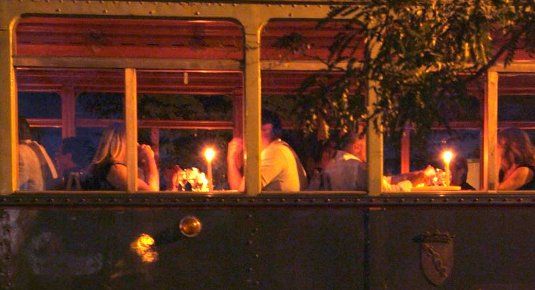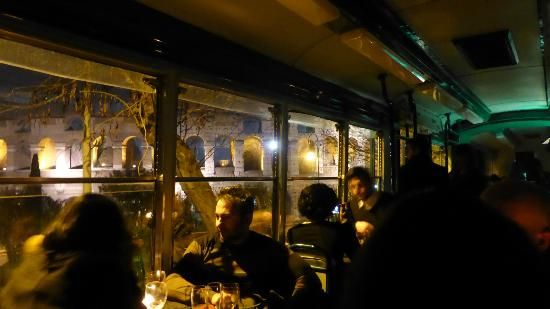Tramjazz offers a unique combination of music, food and sightseeing in Rome.
If you’re looking for a really original way to get to know Rome, if you want to discover the secret of the dreamy atmosphere that makes it so truly unique and inimitable, try a trip on Tramjazz.The Stanga 1947 model isn’t just any old tram; it’s a legendary vehicle, the first “bendy-tram” in the capital, the jewel of the historical collection of ATAC, the city’s urban transport company.
Stanga 1947
But it still works perfectly, just like it did on an October morning seven decades ago when it started its run through the Rome streets along route 37 from Piazza Bainsizza to Piazza Cavour. And now, completely restored and restructured, this tram has been turned into an elegant mobile restaurant and concert hall.Our date is at 21.00 on the platform at Piazza di Porta Maggiore. Even the traffic in this busy square can’t veil the charm of this somewhat mysterious place, the ideal starting point for our Roman adventure.
Today’s Porta Maggiore marks the spot where eight of the 11 aqueducts converged to supply water to ancient Rome. The gate was originally a monumental element of the Claudia aqueduct and then around 272 AD it was included in the city walls by Emperor Aurelian.
Magic rituals
Beneath the square an underground place of worship from the first century BC is hidden, probably a neopythagorean temple and the site of magic rituals. Up against the city walls, just a few metres from our meeting point, there is the famous and unusual tomb of Eurysaces the Baker, dated somewhere around 30 BC, with its impressive shape of an ancient oven.Right on time the Tramjazz pulls up. Through the windows we can see the candle-lit tables. It’s hard to hide our surprise at the contrast between the other trams and city buses crossing the square and this one which seems like the carriage of some epic Orient Express of bygone days. We clamber on board this almost imaginary vehicle where we are welcomed with an aperitif, and set off at once on our trip.
Our route takes us through the S. Lorenzo quarter, cradle of Rome’s bohemian lifestyle, along the edge of the university village, down Viale Regina Margherita and Viale Liegi, crossing the Trieste and Salario quarters. The tram glides through the city at just the right, gentle pace.
Through the windows we can’t hear the city’s noise; we only see the shimmering scenes of a dreamlike metropolis, constantly confusing and transforming reality and fiction, memory and present, in a seductive and changing tale.
Wine
Our first course is served during this initial stage of our nocturnal exploration. The dinner, provided by Il S. Michele restaurant, is made up of typical dishes and produce from Rome and Lazio. The wine list boasts the best regional labels, as well as a selection of selected wines from other areas of Italy. At the time of writing, the La Querciola winery is offering products from the Langhe, one of the Bel Paese’s best-known wine producing regions.After Piazza Ungheria and on the edge of Parioli, we begin the gentle drop of Via Aldrovandi towards Piazza Thorwaldsen in Valle Giulia, deep in the green oasis of the historical park of Villa Borghese.
There is a pause in front of the Galleria Nazionale d'Arte Moderna: the Tramjazz stage-lights come on and we enjoy the first part of the concert. The live music takes on a truly captivating character, everything snug and like chamber music. Some of the best-known jazz musicians from the Italian and international scene play on board the Tramjazz.
Among those who often take part are Lutte Berg, Gabriele Coen, Valbilene Coutinho, Maurizio Giammarco, Alessandro Gwiss, Max Ionata, Jed Levy, Gabriele Mirabassi, Tony Monaco, Jim Mullen, Gegè Munari, Jim Porto, Michael Rosen, Alex Sipiagin, Bill Smith, Joyce Yuille, and many others.
Second course
At the end of this first scene, the tram sets off again in the opposite direction, slowly threading its way through the city, while we enjoy the second course of the dinner. The waiters are discreet and polite as they pass between the tables, refilling our glasses and serving the courses with the grace of dancers or circus artists.We cross Piazza di Porta Maggiore once more and carry on to the Basilica of S. Croce in Gerusalemme, with its well-known, late baroque façade, glowing in the moonlight. It takes its name from one of the Catholic Church’s most famous relics: fragments of Christ’s cross, which as tradition holds were found by St Helen on Mount Calvary in Jerusalem.
Now we reach Piazza di S. Giovanni in Laterano and roll past the basilica, believed to be the oldest in the west as its foundation was laid 14 years before that of St Peter’s. The imposing travertine façade, however, was added in 1735 by the architect Alessandro Galilei. We follow Via Labicana towards the Roman Forum as far as the Colosseum, and halt at the platform right in front of the Flavian amphitheatre.
Colosseum
Here we can get off the tram and admire the Colosseum and the Forum, take our photos, compare notes, and share all the romantic sentiment inspired by the setting.Soon it’s time to return to our tables: the concert is about to start again and we can concentrate on our new musical adventure. Many different musical themes meet on board Tramjazz: bossa nova, tango, gypsy, klezmer and popular traditions from Italy and Europe, all flowing into the luxuriant field of jazz.
Circus Maximus
Once the concert is over, our trip continues as dessert is served. We pass the edge of Circus Maximus in the valley between the Palatine and Aventine hills. This was planned for sport events, especially for the Roman chariot races, sometimes as many as 100 in a day, lasting from early morning until dusk. Julius Caesar often watched the competitions, but only in order to be seen in public; in fact he was totally uninterested in the sport, to the point that he usually brought something to read. Nero, on the other hand, apparently hardly did anything else, and was himself a charioteer.Our route takes us to the Cestia Pyramid. Over 36 metres high, it was built between 18 and 12 BC as a tomb for Caius Cestius of the Epulones, and is a sign of the fashionable Egyptian style which swept Rome in those times, after Egypt had become a province of the empire in 30 BC.
Return journey
Here the Tramjazz circles the square and sets off on its return journey.Once again we plunge into the Caelian park, easing past the Colosseum, and then drift gently down Via Labicana to return to the platform in Piazza di Porta Maggiore, the end of our itinerary.
It’s midnight. Our voyage is over, and we make our farewells. But perhaps we don’t yet want to loosen the knot and put an end to this story – perhaps we want to carry on dreaming...
By Antonio Capaccio
This article first appeared in the January 2015 edition of Wanted in Rome. For more details about TramJazz see website. Cover photo Zingarate.
Update: Note that the covid-19 Green Pass is required.
General Info
View on Map
TramJazz in Rome: An adventure in music
Piazza di Porta Maggiore, Rome, Metropolitan City of Rome, Italy
























